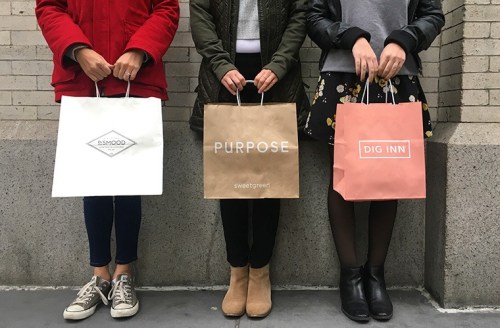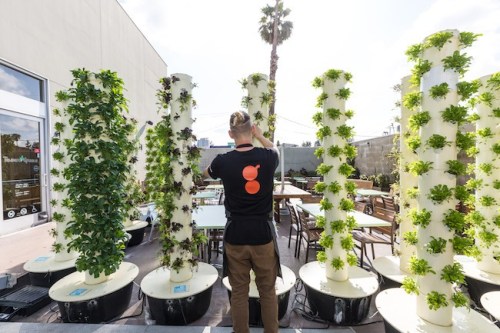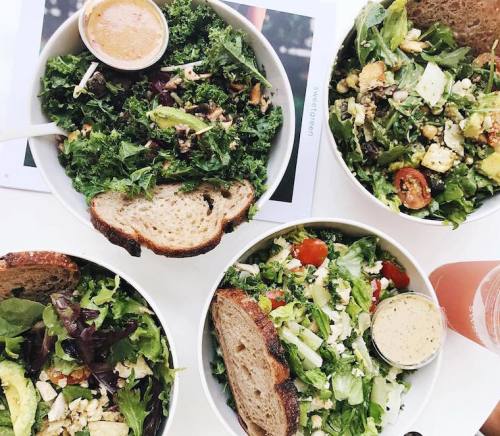The Plus Factor: Why healthy fast-casual dining is the new fast food
The founders of Sweetgreen, Tender Greens, Dig Inn, Dr Smood, and Made Nice sound off on the trend of healthy fast-casual dining, and where it's going next.

This week on The Plus Factor, we’re talking about the healthy fast-casual revolution. Sure, it’s awesome that it’s becoming as easy to get an organic grain bowl as a Big Mac. But why now and where is the trend going next? Here, industry insiders sound off.
You have exactly 20 minutes to leave the office and grab lunch before jumping on a conference call. It’s one of those days (again) where fast food is your only option. So, you pull out your phone, order your already-saved customized Sweetgreen salad using the app, walk to the closest location (they’re popping up everywhere lately at this point), skip the mega-long line, grab your already-processed order, and get back to your desk with five minutes to spare. Sound familiar?
The concept of “fast food” has completely changed in the past few years. Sure, burger chains like McDonald’s and Wendy’s—with trademark fluorescent lighting that (not so) subtly encourages their get-in-and-get-out dining philosophy—are still making bank. But a sub-category, “fast casual,” has emerged in recent years, giving the traditional format some healthy competition—pun intended.
Organic, farm-to-table grab-and-go food is becoming as easy to find as a Whopper.
With more than 70 locations across the US (clustered mainly on the East and West coasts, as well as Illinois and Pennsylvania), Sweetgreen is the perhaps the best example of the healthy fast-casual boom, but it isn’t the only player—not by a long shot.
Organic, farm-to-table grab-and-go food is becoming as easy to find as a Whopper. The shift is a welcome one, but how did it happen and how will the healthy fast-casual dining scene continue to evolve?
Keep reading to find out why healthy fast casual dining is everywhere—and why it’s here to stay.

The cultural connection to food has changed
“When we founded Sweetgreen 10 years ago, the food landscape was in a very different place,” co-founder Nic Jammet says. “It’s been incredible to see how people’s connection to food has changed, especially in the last few years.” Jammet says when they first entered the scene, no restaurant was really expected to call out where their food was coming from—especially when customers were picking up something fast and (relatively) cheap. Now, they are not only demanding healthy options, but they want them to be sustainably sourced.
“We are definitely seeing a health movement, not a fad,” Bonnie Riggs, a restaurant industry analyst at research firm The NPD Group, predicted last year. “Consumers report healthy as the No. 1 characteristic they want to see more of on restaurant menus, and what they mean by that is they’re looking for food that’s real.”
“When you can look at your plate and the garden at the same time, it forms a whole new connection to your food.” —Erik Oberholtzer, co-founder of Tender Greens
What does “real” mean? Tender Greens is betting that farm-to-table is the answer. The West Coast-based brand takes the ethos as literally as you can, by growing food next to the tables. Vertical gardens are installed at each location, which are harvested once a week. “When you can look at your plate and the garden at the same time, it forms a whole new connection to your food,” co-founder Erik Oberholtzer says.
They are another healthy fast-casual brand that’s been on the scene for a while, since 2006 to be exact. Now with 25 West Coast locations, the chain is expanding to New York City and Boston in 2018, thanks largely to an investment from Danny Meyers’ hospitality group, Union Square Hospitality Group. “Back in 2006 in Los Angeles, there were very expensive restaurants that many people couldn’t really afford, and there was fast food that didn’t fit the healthy food culture,” Oberholtzer says.
Tender Greens aimed to bridge that gap, offering the farm-to-table cuisine at prices that could potentially draw people in several times a week. Today, for instance, almost all Tender Greens entrees range from $11 to $15—or less than half the cost of a typical boutique fitness class.

More education has led to healthier food choices
One of the fastest-growing new healthy fast-casual chains is Dr Smood, where everything on the menu is anti-inflammatory. The whole place is a dairy-free zone, and the menu is 80 percent plant-based. “I think the reason why people are willing to spend their money on healthy grab-and-go food is because they just know so much more now,” says holistic nutritionist Etti Ben-Zion, PhD, whom the brand tapped to craft the menu.
“We see that disease is directly correlated to lifestyle choices, and first and foremost, it comes down to what we eat,” Dr. Ben-Zion says. “Now that people know that, they are more willing to invest in healthy food. It’s cheaper in the long run than treating a disease.”
“If a larger percentage of the overall tide is represented with brands like ours, it’s good for everyone. It’s good for agriculture, awareness, and ultimately good for overall health.”
Even so, Dig Inn founder Adam Eskin says the scene is nowhere near the tipping point. “When you consider fast-food places, like McDonald’s or Wendy’s, and also casual dining brands that have been around for decades like Chili’s and Applebee’s, healthy fast casual is still just a small percentage of the market,” he says. (The fast-casual market in the US is predicted to grow to $67 billion by 2020, compared fast food’s expected $223 billion valuation in the same year.) It’s why Eskin has an “all ships rise” mentality about the changing tide.
“If a larger percentage of the overall tide is represented with brands like ours, it’s good for everyone,” he says. “It’s good for agriculture, awareness, and ultimately good for overall health.”

The boutique fitness connection
Even though the demand for quick, healthy food has increased, the restaurants that are popping up aren’t designed with overly bright lighting and minimal seating like the Burger Kings and Wendy’s of your childhood. In fact, quite the opposite. They are thoughtfully designed, often with soft lighting and communal tables, urging customers to sit and stay a while.
Made Nice, the New York City fast-casual eatery opened by Eleven Madison Park’s restaurant group, sees plenty of action at lunchtime. But general manager Kirk Kelewae says they are increasingly becoming busy after work, too. “We’re located near a lot of gyms and boutique fitness studios, so people want to come and eat somewhere they still feel comfortable in their post-workout attire,” he says. “You go to a workout that is challenging and ultimately you feel good about it, so then you want to do something else good for your body.” (AKA not binging greasy takeout as a “reward.”) When you’re already spending $34 on a workout, it isn’t that much of a leap to spend $12 on something else that’s good for your body.
“People want to come and eat somewhere they still feel comfortable in their post-workout attire.”
So, where will the healthy fast-casual scene go next? Dr. Ben-Zion says she expects consumers to continue to demand transparency. Eskin, of Dig Inn, says as more brands enter the space, the healthy competition will cause things to get better and better. “We’re pushing each other to be more thoughtful,” he says. “That could mean pushing the envelope on the supply side or even on the restaurant design side.”
Eskin, Jammet, and Kelewae all say convenience will continue to be a focus too, with brands focused on getting customers their fave healthy salads and grain bowls even faster. Sweetgreen, Tender Greens, and Dig Inn already have apps where customers can order online, and Made Nice has a collaboration with Caviar, for at-home delivery. “We know when people are home from work, because that’s when our delivery orders start to spike,” Kelewae says, illustrating that customers are clearly interested in getting their health fix the easiest way possible.
One thing is certain: This isn’t a “here today, gone tomorrow” trend. Says Eskin, “The vegetable of the year may change, but the work we’re all doing will continue to grow.”
Co-working culinary spaces are also causing a healthy food revolution. Plus, here’s where you can get matcha on-the-go.
Sign Up for Our Daily Newsletter
Get all the latest in wellness, trends, food, fitness, beauty, and more delivered right to your inbox.
Got it, you've been added to our email list.










